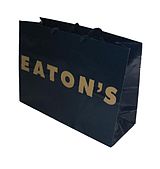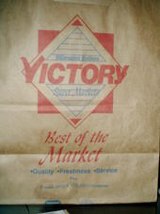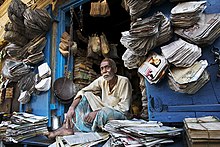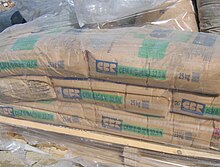Paper bag
This article's lead section may be too short to adequately summarize the key points. (October 2021) |





A paper bag is a bag made of paper, usually kraft paper. Paper bags can be made either with virgin or recycled fibres to meet customers’ demands. Paper bags are commonly used as shopping carrier bags and for packaging of some consumer goods. They carry a wide range of products from groceries, glass bottles, clothing, books, toiletries, electronics and various other goods and can also function as means of transport in day-to-day activities.
History[]
In 1852, Francis Wolle, a schoolteacher, invented the first machine to mass-produce paper bags.[1] Wolle and his brother patented the machine and founded the Union Paper Bag Company.
In 1853, James Baldwin, papermaker of Birmingham and Kings Norton in England, was granted a patent for apparatus to make square-bottomed paper bags. Thereafter he used an image of a flat-bottomed bag as his business logo.[2]
In 1871, inventor Margaret E. Knight designed a machine that could create flat-bottomed paper bags, which could carry more than the previous envelope-style design.
In 1883, Charles Stilwell patented a machine that made square-bottom paper bags with pleated sides, making them easier to fold and store.[3][4] This style of bag came to be known as the S.O.S., or "Self-Opening Sack".[5]
In 1912, Walter Deubener, a grocer in Saint Paul, Minnesota, used cord to reinforce paper bags and add carrying handles. These "Deubener Shopping Bags" could carry up to 75 pounds at a time, and became quite popular, selling over a million bags a year by 1915. Paper bags with handles later became the standard for department stores, and were often printed with the store's logo or brand colors.
Plastic bags were introduced in the 1970s, and thanks to their lower cost, eventually replaced paper bags as the bag of choice for grocery stores.[6] With the trend towards phasing out lightweight plastic bags, though, some grocers and shoppers have switched back to paper bags.[7]
In 2015, the world's largest paper shopping bag was made in the UK and recorded by Guinness World Records.[8] Also in 2015: The European Union adopted directive (EU) 2015/720, that requires a reduction in the consumption of single use plastic bags per person to 90 by the year 2019 and to 40 by the year 2025.[9]
In 2018, the “European Paper Bag Day” was established by the platform The Paper Bag, an association of the leading European kraft paper manufacturers and producers of paper bags. The annual action day takes place on 18 October and aims to raise awareness among consumers about paper carrier bags as a sustainable packaging solution. It was launched to encourage more people to act responsibly and use, reuse and recycle paper bags. With different activities on local level, the association wants to open a dialogue with consumers and give them revealing insights about paper packaging.[10]
In April 2019, the European Union adopted Directive (EU) 2019/904 of the European Parliament and of the Council of 5 June 2019 on the reduction of the impact of certain plastic products on the environment.[11]
Construction[]
Standard brown paper bags are made from kraft paper. Tote-style paper carrier bags, such as those often used by department stores or as gift bags, can be made from any kind of paper, and come in any color. There are two different styles of handles for paper carrier bags: flat handles and cord handles. Paper carrier bags made from virgin kraft paper are developed especially for demanding packaging. Paper bags can be made from recycled paper, with some local laws requiring bags to have a minimum percentage of post-consumer recycled content.[12]
Paper bags can be made to withstand more pressure or weight than plastic bags do.
Single layer[]

Paper shopping bags, brown paper bags, grocery bags, paper bread bags and other light duty bags have a single layer of paper. A variety of constructions and designs are available. Many are printed with the names of stores and brands. Paper bags are not waterproof. Types of paper bag are: laminated, twisted, flat tap. The laminated bag, whilst not totally waterproof, has a laminate that protects the outside to some degree.[13]
Multiwall paper sacks[]

Multiwall (or multi-wall) paper sacks, also referred to as industrial paper bags, industrial sacks or shipping sacks are often used for packaging and transporting dry powdery and granulated materials such as fertilizer, animal feed, sand, dry chemicals, flour and cement. Many have several layers of sack papers, printed external layer and inner plies.[14] Some paper sacks have a plastic film, foil, or polyethylene coated paper layer in between as a water-repellant, insect resistant, or rodent barrier.

There are two basic designs of bags: open-mouth bags and valve bags. An open-mouth bag is a tube of paper plies with the bottom end sealed. The bag is filled through the open mouth and then closed by stitching, adhesive, or tape. Valve sacks have both ends closed and are filled through a valve. A typical example of a valve bag is the cement sack.
Quality standard and certification[]
Paper bag durability can be measured in accordance with the European test standard EN13590:2003. This standard is based on scientifically conducted studies and helps retailers to avoid poor-quality carrier bags. The quality certification system for paper bags is based on this standard. The test method subjects the carrier bag to heavy weights while being lifted repeatedly. The size of the paper bag is taken into account because the larger its volume, the heavier the load it must be able to carry. As a result of the certification, the paper bag is marked with the weight and volume it may carry. It is wise to choose a tested and certified paper bag.
Sustainability[]
The raw material used in papermaking – cellulose fibre extracted from wood – is a renewable and natural resource. However, environmental concerns have been raised about types of wood harvesting, such as clearcutting. Due to their biodegradable characteristics, paper bags degrade in a short period of time (two to five months).[15] When using natural water-based colours and starch-based adhesives, paper bags do not harm the environment.
Most paper bags that are produced in Europe are made from cellulose fibres that are sourced from sustainably managed European forests. They are extracted from tree thinning and from process waste from the sawn timber industry. Sustainable forest management maintains biodiversity and ecosystems and provides a habitat for wildlife, recreational areas and jobs. This sustainable forest management is proven in the FSC® or PEFC™ certifications of paper products. Consumers can look for the FSC and PEFC labels on their paper bags to make sure they are made from sustainably sourced fibres.
As a wood product, paper continues to store carbon throughout its lifetime. This carbon sequestration time is extended when the paper is recycled, because the carbon remains in the cellulose fibres.
Paper bags can be used several times. Paper bag manufacturers recommend reusing paper carrier bags as often as possible in order to further decrease the environmental impact.
Recycling[]
Paper bags are highly biodegradable and recyclable, and hence does not pose the same environmental footprint as plastic bags do. The fibres are reused 3.6 times on average in Europe, while the world average is 2.4 times.[16]
Plastic or water-resistant coatings or layers make recycling more difficult.[17] Paper bag recycling is done through the re-pulping of the paper recycling and pressing into the required shapes.
Safety[]
Compared to plastic bags, paper bags present less suffocation risk to young children or animals.
Branding and marketing[]
Paper shopping bags can be used as a vehicle to project the brand image of retailers. Paper is very tactile due to its texture and shape. Its print quality and color reproduction allow for creativity in advertising and development of the brand image. Furthermore, they achieve maximum visibility and great appreciation from customers. Using paper bags gives a signal of commitment to the environment and by using packaging made from renewable, recyclable and biodegradable sources, retailers and brand owners contribute to reducing the use of non-biodegradable shopping bags. Paper carrier bags can be a visible part of corporate social responsibility, and they are in line with a sustainable consumer lifestyle.[18]
Brown bag[]
While brown is the color of the most common type of paper bag (brown being the natural color of the wood fibre), this pair of words connotes more than just the color.
The verb form of brown bag, depending on content, may be an act of civil disobedience (and illegal)[19] or an action by "60 million American brown baggers" whom a marketing research study's review by the New York Times described as "upscale."[20]
The former refers to lack of a liquor license, whereas the latter are for "particularly those on vegetarian, low-salt, low-cholesterol or kosher diets."
The noun form of the term included in the Merriam-Webster dictionary in 1950 refers to use of a paper bag instead of a lunch box. William Safire traces this to an article in Time magazine.
When the content is solid food, it may be preserved or enhanced before being consumed because "a substantial minority of brown baggers have access to microwave ovens or refrigerators."[20]
Anti-brown-bag law in New York, USA[]
The words "Brown-bagging is the genteel disguise ... by a patron to furnish his own liquor when he dines at the local restaurant" were published in 1967.[19]
To prevent individuals (or groups) from bringing alcoholic beverages into food establishments that lack a liquor license, in 1985 the New York State Liquor Authority pushed for legislation that New York City's Mayor Ed Koch denounced, months after being "arrested" for this.[21] The New York Times noted that some call the bill "the anti-brown-bag law."[19]
Brown Bag Report[]
The advertising agent who, prior to the Marlboro Man,[20] developed ads for the product as a filtered "feminine brand"[18][22]: p.LB-6 in 1981 developed "The Brown-Bag Report" with funding from Swift, Carnation, General Mills and American Can.
Symbolism[]
While in the United States the lunch box or lunch pail has been used as a symbol of the working class, Safire wrote: "In the metaphor of the modern worker, the brown bag has replaced the lunch pail."[19]
About a third of the brown baggers are schoolchildren.[20]
Associations[]
The platform The Paper Bag consists of leading European paper manufacturers and producers of paper bags. It was created in 2017 to represent the interests of the European paper bag industry and to promote the advantages of paper packaging. The Paper Bag is steered by the organisations CEPI Eurokraft and EUROSAC.
Other uses[]
Paper bags are commonly used for carrying items. However, they have been used for other purposes. In 1911, the English chef Nicolas Soyer wrote a cookbook, Paper-Bag Cookery, about how to use clean, odorless paper bags for cooking, as an extension of the en papillote technique and an alternative to pots and pans.[23][24]
References[]
- ^ "Patent US9355". Archived from the original on May 19, 2017. Retrieved March 6, 2013.
- ^ Letters Patent No 2190, dated 22 September 1853 and sealed 22 March 1854, to James Baldwin of Birmingham in the County of Warwick, Paper Manufacturer, for the Invention of “Improvements in the Making of Paper Bags.”
- ^ Stilwell, Charles B., "Paper bag", U.S. patent no. 405,616 (issued: 18 June 1889).
- ^ "Charles Stilwell". Ohio History Central. Archived from the original on 2019-05-04. Retrieved 2015-06-10.
- ^ "MoMA | Margaret E. Knight and Charles B. Stilwell. Flat-Bottomed Paper Bag. 1870s-1880s". Archived from the original on 2017-02-07. Retrieved 2015-06-10.
- ^ Ball, Jeffrey (2009-06-12). "Paper or Plastic? A New Look at the Bag Scourge". The Wall Street Journal. Archived from the original on 2015-06-12. Retrieved 2015-06-11.
- ^ Pereira, Andrew (2015-06-09). "Oahu's bag ban includes exemptions and substitutes". KITV.com. Archived from the original on June 13, 2015. Retrieved 2015-06-11.
- ^ "largest shopping bag made from paper". Guinness World Records. Archived from the original on 2019-06-05. Retrieved 2015-11-10.
- ^ Directive (EU) 2015/720 of the European Parliament and of the Council of 29 April 2015 amending Directive 94/62/EC as regards reducing the consumption of lightweight plastic carrier bags
- ^ The Paper Bag. “European Paper Bag Day”.
- ^ DIRECTIVE (EU) 2019/904 OF THE EUROPEAN PARLIAMENT AND OF THE COUNCIL of 5 June 2019on the reduction of the impact of certain plastic products on the environment
- ^ "California - Bag Legislation". BagLaws.com. 2014-09-30. Archived from the original on 2015-06-13. Retrieved 2015-06-11.
- ^ "Kenya Bureau of Standards (KEBS) : Paper bags – specification" (PDF). Archived (PDF) from the original on 2019-12-11. Retrieved 2019-12-11.
- ^ Paulapuro, Hannu (2000). "5". Paper and Board grades. Papermaking Science and Technology. Vol. 18. Finland: Fapet Oy. pp. 121–122. ISBN 978-952-5216-18-9.
- ^ The Paper Bag “For the environment”
- ^ European Paper Recycling Council “MONITORING REPORT 2019, page 7
- ^ R. McKinney: Technology of Paper Recycling, 1995, p. 351. ISBN 9780751400175
- ^ a b "Leo Burnett, still reaching for the stars after 60 years". Advertising Age. July 31, 1995.
- ^ a b c d William Safire (September 16, 1985). "On Language: Arcane Brown Bag". The New York Times. Archived from the original on July 17, 2020. Retrieved July 17, 2020.
- ^ a b c d Samuel G. Freedman (January 5, 1983). "The flavor of the Brown-Bag way of life". The New York Times. Archived from the original on July 17, 2020. Retrieved July 17, 2020.
- ^ Sydney H. Schanberg (March 20, 1984). "Bagging the brown bag mob". The New York Times. Archived from the original on July 18, 2020. Retrieved July 17, 2020.
- ^ "Burnett repositioned Marlboro cigarettes from a feminine brand to one that shouted masculinity"
- ^ Finck, Henry (2001). Food and Flavor: A Gastronomic Guide to Health and Good Living. Applewood Books. p. 148. ISBN 978-1-4290-1109-9. Archived from the original on 2021-09-10. Retrieved 2021-05-28.
- ^ Soyer, Nicolas (1911). Soyer's Paper-bag Cookery. Sturgis & Walton Company. Archived from the original on 2021-09-10. Retrieved 2021-05-19.
Further reading[]
| Wikimedia Commons has media related to Paper bags. |
- Yam, K. L., "Encyclopedia of Packaging Technology", John Wiley & Sons, 2009, ISBN 978-0-470-08704-6 doi:10.1002/9780470541395
- American inventions
- Bags
- Paper products
- Domestic implements
- Food storage containers
- Disposable products